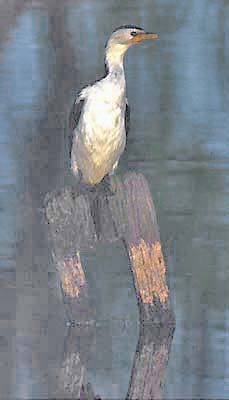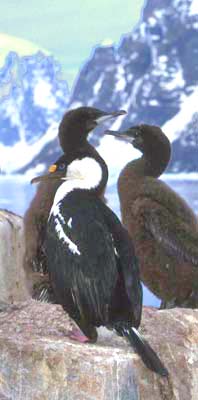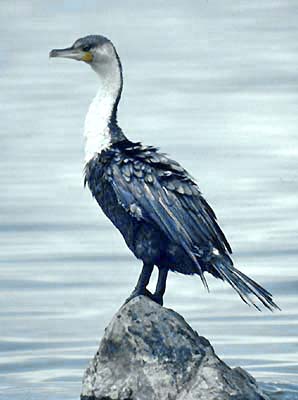
a web page by Don Roberson |
CORMORANTS Phalacrocoracidae |
|||
|
|||
Cormorants are found almost everywhere that water meets shore. They use traditional sites for roosting, sunning, and nesting. These tend to be on islets, jetties, docks, or drowned trees with a 360 degree view to avoid predators. Cormorants are often easy to see, but they can be quite difficult to approach.
|
|||
As an aside, the Neotropic Cormorant used to be known as "Olivaceous Cormorant P. olivaceus" but recent research (Browning 1989) showed that the earlier-described brasilianus was this species, and Neotropic Cormorant defines the species' range quite well. The 7th ed. A.O.U. checklist (1998) accepts these changes, although Orta (1992) didn't approve. |
|||
 |
|||
Although rather a plain bird most of the year, the adult Brandt's Cormorant in breeding condition (left) is very impressive in its breeding finery (white plumes on the head) and exotic displays with the colorful throat pouch (left). Here on the central coast of California, the displays are underway in March-April; eggs are laid in April-May; and youngsters are in the nest June-July (Bailey 1993). |
|||
The bright colors of bare skin in courting adults are quickly lost when the eggs are laid and there is no more pressure to attract mates. By the time the eggs hatch, adults are quite cull (right) The new youngsters are very ungainly and almost reptilian. It will take six weeks for them to grow to full size and fledge. This species — as are other cormorants around the world — is very susceptible to highs and lows in breeding success, depending on sea surface temperatures and the abundance of their piscine prey. In 'warm water' years, when the prey base can completely collapses and there is nothing to feed the young, the entire nesting colony can be abandoned at mid-season (Ainley & Boekelheide 1990). Brandt's are also particularly susceptible to calamities such as oil spills, as they tend to breed in large colonies at few sites. Placing all their eggs in just a few such baskets, if you will, can be tragic if the oil spill is nearby. |
|||
|
|||
Another badly misnamed species, both in English and in its Latin scientific name, is Pelagic Cormorant P. pelagicus (left) of the northeast Pacific. While it breeds on oceanic shores, it almost never ventures more than a mile offshore. It is actually the least "pelagic" of the three species on Monterey Bay — Brandt's and Double-crested are regularly seen farther offshore. Pelagic Cormorant does have a lovely purple and green gloss on its feathers, especially apparent in breeding season, when it also also a blazing white flank patch. Like many other cormorants, the bare facial colors intensify at this season. In the spring, the face of an adult Pelagic Cormorant is an intensely bright, deep red. It is very dull reddish the rest of the year. |
|||
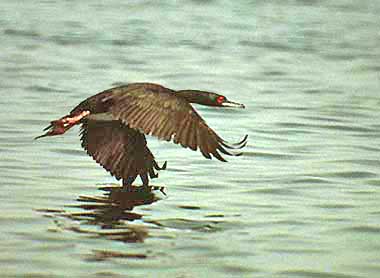 As
cormorants use traditional breeding and roosting sites, their droppings
layer up, staining the rocks year after years. In dry areas where rain
does not regularly wash the rocks, such as on the islets of the coast
of Peru, this guano [the Quechua word for excrement] has built up for
2000 years. This guano is rich is nitrates and during the 19th century
there was a major demand for the guano for fertilizer. From 1948–1875
some 20 million tons (!) were exported from the guano islands of Peru
to the U.S. and Europe (Orta 1992). The predominant cormorant here,
named for this phenomena, is Guanay Cormorant
(right). The occur along the Peruvian coast is vast numbers during
normal upwelling times, but populations are decimated and dispersed
during major El Niños. As
cormorants use traditional breeding and roosting sites, their droppings
layer up, staining the rocks year after years. In dry areas where rain
does not regularly wash the rocks, such as on the islets of the coast
of Peru, this guano [the Quechua word for excrement] has built up for
2000 years. This guano is rich is nitrates and during the 19th century
there was a major demand for the guano for fertilizer. From 1948–1875
some 20 million tons (!) were exported from the guano islands of Peru
to the U.S. and Europe (Orta 1992). The predominant cormorant here,
named for this phenomena, is Guanay Cormorant
(right). The occur along the Peruvian coast is vast numbers during
normal upwelling times, but populations are decimated and dispersed
during major El Niños. |
|||
| The three species shown below include two tropical species — Little Pied Cormorant (left) of Australasia and the "white-breasted" race of Great Cormorant of tropical Africa (right) — flanking a nest of Antarctic Shag (center; photo by Greg Lasley). | |||
|
|||
| Some older African books consider the white-breasted race lucidus to be a separate species, but more modern texts tend to lump it with the worldwide Great Cormorant P. carbo (e.g., AOU 1998). But it is the southern shags — especially the "blue-eyed shags" of which the Antarctic is usually considered one of 3–4 species — where there is most debate about species-level taxonomy. There are separate populations on many subantarctic islands — such as Heard, Crozet, Kerguelen — that are usually considered subspecies of Imperial Shag P. atriceps. Orta (1992) splits them all. Other questions arise about allopatric island populations in and south of New Zealand. We can expect more research on these topics in the future. | |||
Photos: The sunning Crowned Cormorant Phalacrocorax coronatus was at Cape Town, South Africa, on 1 July 2005 The close-up of Neotropic Cormorant P. brasilianus was taken in the Brazilian Pantanal in August 1999. Scenes and individual Brandt's Coromant P. penicillatus were at Monterey, California, in March (courtship) & July (nestlings) 2006. The Double-crested Cormorant P. auritus was at Monterey in May 2008. The colonial Pied Cormorants P. varius were at Helena Bay, North I., New Zealand, in Dec 1997. The flying Guanay Cormorant P. bouganvillii was just off the Paracas Peninsula, Peru, on 12 June 1987. The Little Pied Cormorant P. melanoleucos was near Sydney, New South Wales, Australia, in Sep 1983. Greg Lasley photographed the nesting Antarctic Shag P. bransfieldensis on the Peteman Is., Antarctica, on 20 Jan 1999. The Great ("White-breasted") Cormorant P. carbo lucidus was on Lake Nakuru, Kenya, on 17 Nov 1981. All photos © D. Roberson except the shag, © Greg W. Lasley and used with permission; all rights reserved. Bibliographic note: There is no "family book" per se of which I'm aware (there are numerous coffee-table "survey" books that include cormorants among other waterbirds), but a good introduction to the family, with a fine collection of color photos, is in Orta (1992). Literature cited:
|
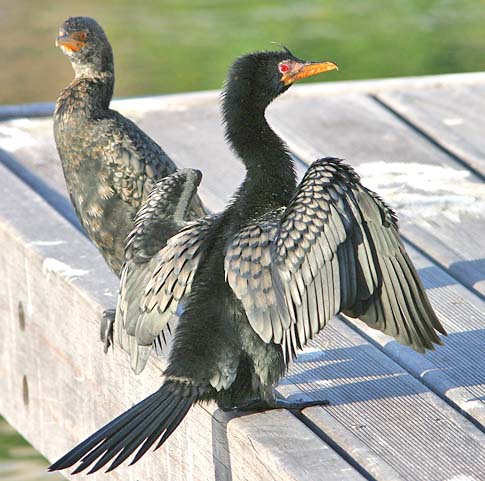 The
Cormorants are a fairly large family of fisheaters residing along
freshwater and saltwater shores around the world, yet all are so
closely related that all are usually placed within a single genus Phalacrocorax.
Despite spending much time in the water, they do not possess the
waterproofing oil of other seabirds and so must spend much time drying
their wings. That's what the Crowned Cormorant at Cape Town, South Africa, is doing (left).
The
Cormorants are a fairly large family of fisheaters residing along
freshwater and saltwater shores around the world, yet all are so
closely related that all are usually placed within a single genus Phalacrocorax.
Despite spending much time in the water, they do not possess the
waterproofing oil of other seabirds and so must spend much time drying
their wings. That's what the Crowned Cormorant at Cape Town, South Africa, is doing (left).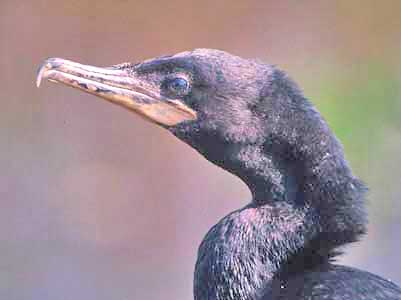 Their hooked bills and bare pouches have evolved to deal with fish; details can be seen on this close-up of the head of Neotropic Cormorant (right), a photo I took out the car window in the Brazilian Pantanal where this species is abundant.
Their hooked bills and bare pouches have evolved to deal with fish; details can be seen on this close-up of the head of Neotropic Cormorant (right), a photo I took out the car window in the Brazilian Pantanal where this species is abundant.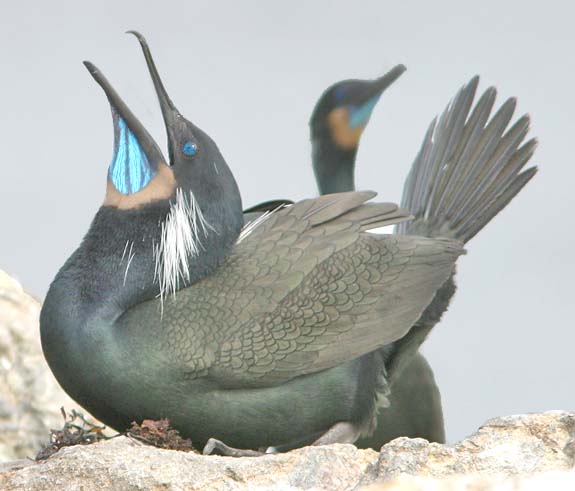 Where I live in Monterey, California, our common coastal species is Brandt's Cormorant,
which has taken over the jetty of the harbor as a breeding locale
within the last decade (below). These rocks were once claimed by
sea-lions (and still are in winter) but now, in spring, the cormorants
are king of the jetty.
Where I live in Monterey, California, our common coastal species is Brandt's Cormorant,
which has taken over the jetty of the harbor as a breeding locale
within the last decade (below). These rocks were once claimed by
sea-lions (and still are in winter) but now, in spring, the cormorants
are king of the jetty.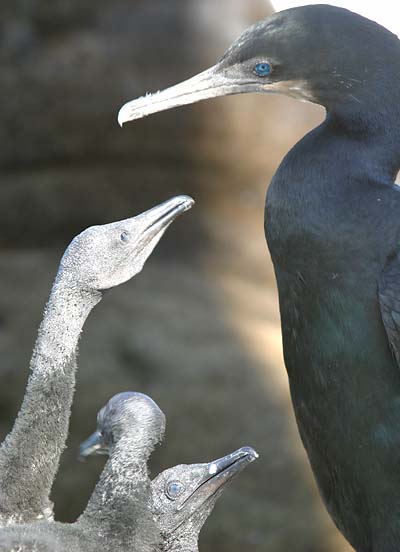 The
timing of breeding is tied to lattitude and prey populations. Colonies
in southern California are a month earlier; those to the north can be a
month later to initiate (Ainley & Boekelheide 1990).
The
timing of breeding is tied to lattitude and prey populations. Colonies
in southern California are a month earlier; those to the north can be a
month later to initiate (Ainley & Boekelheide 1990).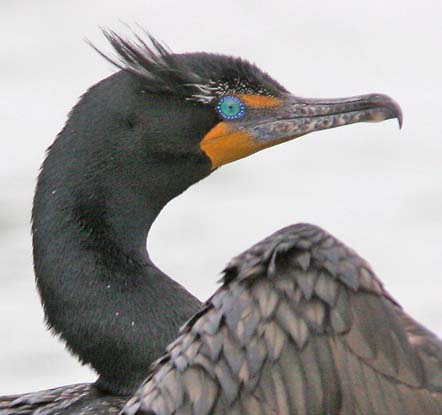
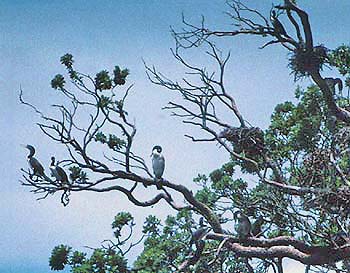
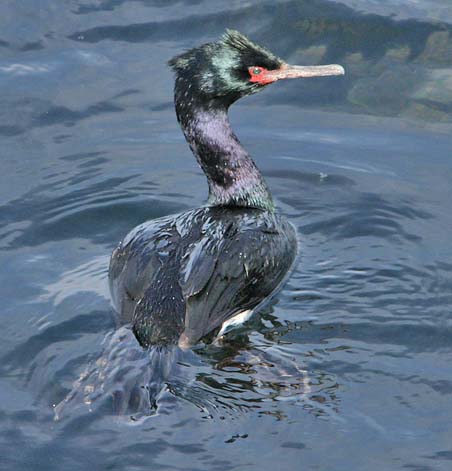 Speaking of Double-crested Cormorant,
it is among the most misnamed species in English, as its "double crest"
of black-and-white wisps is present only during a transient time during
the breeding season (above left), when the pouch and eye color also
intensify.
Speaking of Double-crested Cormorant,
it is among the most misnamed species in English, as its "double crest"
of black-and-white wisps is present only during a transient time during
the breeding season (above left), when the pouch and eye color also
intensify.